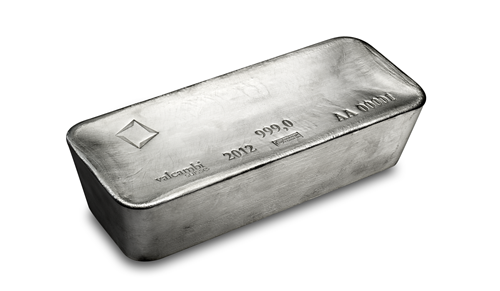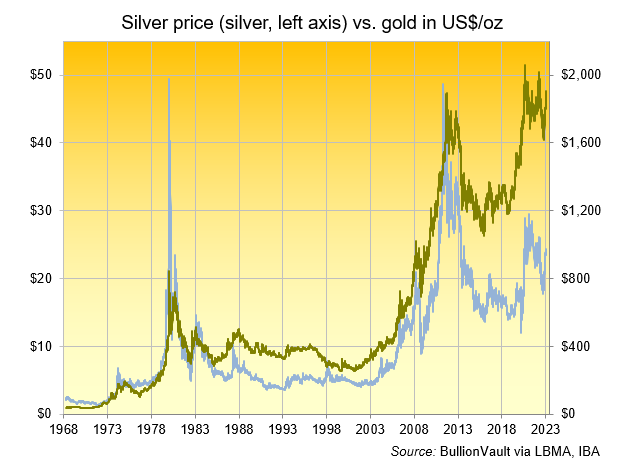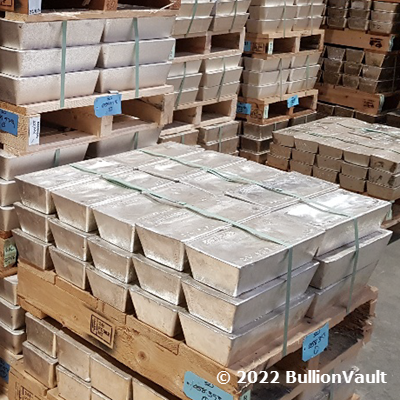Why you should consider silver investment
Why invest in silver?
Silver has been used as a store of wealth for 5,000 years and even as recently as 1964 US quarters were made of 90% silver. Today silver bullion coins such as the UK's 1-ounce silver Britannia (99.99% pure silver) still carry a face value of £2 despite the metal content alone being worth approximately £17 at today's silver prices.
Silver has been used for jewellery and precious objects for as long as it has been a store of value. However, as the supply of silver increased relative to gold so its value compared to gold diminished. It is believed that by about 1600BC the availability of silver was such that it had fallen to half the price of gold. Today an ounce of silver costs a little above 1% the price of gold.
Silver's availability, plus its unique properties as a precious metal, now underpins its many industrial, medical and technological uses. This sets silver apart from gold as an asset to invest in, by making it an indispensable metal for the modern age.

What are silver's industrial uses?
Silver has anti-microbial and non-toxic properties which explains why some of silver's earliest uses were in the storage of fresh foods and liquids, wild west cowboys used to place a silver coin in their milk to prolong its life.
In the 21st century NASA astronauts drink water purified by ionized silver rather than using chlorine, the traditional substance. The silver ions destroy bacteria in the water and are then filtered out. Russian cosmonauts use the same method aboard the International Space Station. Alongside solar disinfection, ceramic filters coated with colloidal silver are also helping bring clean drinking water to developing countries.
Silver is a vital component in making solar panels, because it has the highest electrical and thermal conductivity of any metal. Used in the form of silver paste, the metal catches the sun's rays and transforms them into photovoltaic energy. A typical 3x5-foot solar panel for residential housing will contain up to 20 grams of silver, currently costing about £12 ($15).
Despite solar panel manufacturers trying to reduce silver loadings within each panel silver use in photovoltaics increased 13% to over 3,200 tonnes in 2021. An April 2022 report for the Silver Institute estimates that photovoltaics account for nearly 24% of the world's silver industrial demand, up from 11% in 2013 and 2% in 2006.
The Silver institute also reports "average vehicle silver loadings, which are currently estimated at 15-28 grams (g) per internal combustion engine (ICE) light vehicle, have been rising over the past few decades. In hybrid vehicles, silver use is higher at around 18-34g per light vehicle, while battery electric vehicles (BEVs) are believed to consume in the range of 25-50g of silver per vehicle."
What is silver most used for?
The Silver Institute forecasts global silver demand to reach a record 31.5 thousand tonnes (1.112 billion ounces) in 2022.
Electrical and electronics (including photovoltaics) accounts for the largest share of global silver at 49.0%.
At 25.3% silver bars and coins account for the second biggest area of demand for silver. Jewellery follows closely behind and accounts for 18.3% of demand.
Photography (2.6%) used to consume the largest amount of metal now lags behind silverware 4.8% in terms of global silver demand.
What are the benefits of investing in silver?
Physical silver like gold is widely regarded as a safe haven asset. This means that when the returns on traditional investments such as stocks and shares decline then investors may look to swap a proportion of their capital into assets (such as precious metals) that may hold their value or even increase as other investments returns fall.
The reverse also applies, and physical silver investment prices slipped year after year during the 'Long Boom' enjoyed by Western stock markets during the 1980s and '90s. So did gold.
Silver prices may also struggle or fall when the economic outlook darkens, because its strong industrial uses mean productive demand may drop if recession hits. But its best investment returns have come when the stock market has failed to perform.
Like gold, silver can also provide some protection against inflation because it tends to rise in price when interest rates fall behind the rising cost of living.
This is known as the real interest rate – meaning the returns you get from cash-in-the-bank after you account for inflation. It fell deeply negative in the 1970s, costing savers real money as inflation outran the rate of interest they earned, and it happened during the first decade of the 2000s as well. Again, along with weakness in the stock market, that proved very bullish for investing in silver.
Gold and silver prices tend to move together and since 1968 the two metals have had a very close correlation value of 0.63 (1.0 is a perfect correlation). However, silver prices are more volatile. For every 1% move in gold – up or down – silver moves 3% on average.

When did silver prices hit their all time high?
The answer to this question depends on whether you are interested in the price of silver in GBP or USD.
Examine any silver price chart in Pounds Sterling for the past 20 years and April 2011 stands out as the peak spot price for silver reaching £30.06 per oz (£966.45 per Kg) on 28 April 2011 with the highest daily price (formerly known as the London Fixing) achieving £29.26 per oz (£940.73 per Kg) on the same day.
In US Dollars silver hit its current all time high of $49.45 per Oz ($1,589.85 per Kg) on 18 January 1980 when the Hunt brothers tried to corner the silver market by purchasing physical silver bullion and silver futures contracts which ultimately ended in their failure and the price falling by two thirds to less than $15 per Oz ($482 per Kg) by 15 April 1980.
Are there any annual silver price patterns?
The charts below show the annual price patterns for silver over the past 20 years.
This chart shows how many times, over the last 20 years, each month showed a gain over the previous month for silver in either US Dollar terms, or Euros or British Pounds.
The below chart shows you the last 20 years' average monthly price change for silver in those 3 major currencies, too.
Silver price predictions
We regularly survey BullionVault users on their thoughts about where precious metals prices will trend in the next 12 months. In the most recent survey 25.8% of respondents predict the price of silver will rise by 20% or more by the year end.
For the experts view of how the physical silver supply lagging demand will impact the future price of silver we have three key charts, data and opinions for you to digest.
How to invest in silver bullion
Silver investment can take different forms with the advantages and disadvantages of each summarised in the table below.
Silver jewellery/cutlery/objects
Silver items requiring craftsmanship to produce will immediately cost significantly more than the value of the silver contained within the piece and will also attract VAT, yet when it comes time to sell these individual items they may not achieve any more than value of the silver the are made from.
For these reasons alone silver jewellery and cutlery should not really be considered an investment.
Silver coins and small bars
All silver coins and small bars start out as 1,000 oz (32kg) wholesale bars before being melted down and cast or stamped out into the smaller pieces after incurring additional costs.
All silver coins and small bars incur 20% VAT when they are purchased in the UK. This means that pound sterling prices would have to rise over 20% for a silver coin investor to breakeven, although in reality the price would need to rise further still to see any profit as coin dealers traditionally have a high trading spread (the difference between the price offered to buy a coin back and the price a coin is sold for) that would also eat into any potential profit.
Silver Exchange Traded Funds (ETF) & Commodities (ETC)
Investors that are unconcerned with physical silver bullion ownership can gain exposure to the wholesale silver market via Silver ETFs & ETCs.
These investment products for silver bullion closely track the silver price and whilst they do incur an annual expense ratio to cover the cost of managing the fund and storage, the investor does not own the physical silver and is therefore unlikely to be able to take delivery.
Vaulted wholesale silver bullion

Wholesale silver bullion bars straight from the refinery are the cheapest way to invest in silver. Accepted as 'Good Delivery' by London Bullion Market Association (LBMA) approved vaults these 1,000 oz (32kg) bars are traded and transported around the world from one approved vault to the next VAT free.
Silver investment options
* Paying a storage fee for the safe-keeping of physical assets has, in the past, been decisive in proving that an investor owned the property in law. So where no storage fee is charged, this evidence is lacking.
Silver investment FAQs
It is estimated that Battery Electric Vehicles (BEVs) use twice the silver of Internal Combustion Engined Cars (ICE) which is a positive outlook for future silver demand as the world moves towards more BEVs on the road. Similarly, the use of silver in solar panels and electronics provides significant opportunities for silver going forward.
This highly informative London Bullion Market Association (LBMA) webinar discusses the current and future outlook for silver.
As demand for silver hit new all-time records in 2022, creating the biggest deficit of supply versus demand for many decades, the expert webinar panel agree that this situation is unlikely to change in the near future especially as we move to decarbonise our energy production with wind, solar and green hydrogen.
Silver bullion can be viewed as a good investment depending on the form in which it is bought. Retail silver coins and small bars incur 20% VAT when purchased in the UK, the equivalent gold coins and small bars are not subject to VAT. But Silver is VAT-free when traded in wholesale (1,000 Troy ounce) bar form and stored in LBMA approved vaults as on BullionVault, significantly improving a silver investor's return compared with coins and small bars.
The most profitable way to buy silver is to purchase at the lowest possible price. This means avoiding buying silver where any VAT or sales tax is added. In the UK all silver coins and small retail bars incur an additional 20% VAT over and above the value of the silver when sold.
Wholesale silver bullion in large 1,000 oz (32kg) bars stored within LBMA-member warehouses are traded VAT free. Silver buyers can also benefit from VAT free silver by using BullionVault.
The price of silver in 2030 is difficult to predict, as bullion prices can fluctuate by the second, let alone from year to year.
However, it's possible to view historic and real-time prices using BullionVault's silver price chart. Looking at the 20-year view, you can see that silver prices reached all-time highs in Dollar, Sterling and Euro in March 2011.
When you open a BullionVault account we give you 1/8 oz (4g) of silver bullion, $1 (US Dollar), €1 (Euro) and £1 (British Pound) to buy and sell a few times on our live order board.
This free silver and small amount of currency provided free will cover the commission charges incurred and enable you to trade your free silver numerous times whilst you become familiar with selling and buying on BullionVault.
You cannot withdraw your free silver balance unless you've funded and validated your account, and if you don't we'll take back the silver after a few months, so that someone else can have a go. If you do fund and validate your account you'll be adding to the balance you already own and it will be permanently yours.
How BullionVault enables you to buy silver in a cheaper, safer and easier way
- You buy silver in 1 gram increments within LBMA approved wholesale bars
- You pay prices that are closer to the wholesale market price
- No VAT or Sales Tax
- No delivery costs
- Your gold, silver, platinum & palladium is stored in professional vaults you choose where
- Professional vaults mean you pay the lowest storage & insurance costs
- Buy & sell 24/7 and instantly have funds back in your account ready to be withdrawn
- Users in the United Kingdom can open an account online or via our mobile app and buy silver all in just a few minutes. You can sell at any time
- 5* Trustpilot rating & reviews
- BullionVault manages $7 billion in client property for over 120,000 users




